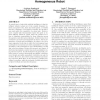79 search results - page 14 / 16 » Reverse-engineering of artificially evolved controllers for ... |
CEC
2010
IEEE
13 years 11 months ago
2010
IEEE
— This work is the first attempt to investigate the neural dynamics of a simulated robotic agent engaged in minimally cognitive tasks by employing evolved instances of the Kuram...
ECAL
1999
Springer
14 years 3 months ago
1999
Springer
Abstract. This paper is concerned with arti cial evolution of neurocontrollers with adaptive synapses for autonomous mobile robots. The method consists of encoding on the genotype ...
CEC
2010
IEEE
13 years 11 months ago
2010
IEEE
Abstract— In Evolutionary Robotics (ER), explicitly rewarding for behavioral diversity recently revealed to generate efficient results without recourse to complex fitness funct...
GECCO
2009
Springer
14 years 5 months ago
2009
Springer
A central tenet of embodied artificial intelligence is that intelligent behavior arises out of the coupled dynamics between an agent’s body, brain and environment. It follows t...
GECCO
2007
Springer
14 years 2 months ago
2007
Springer
The development of coherent and dynamic behaviors for mobile robots is an exceedingly complex endeavor ruled by task objectives, environmental dynamics and the interactions within...

